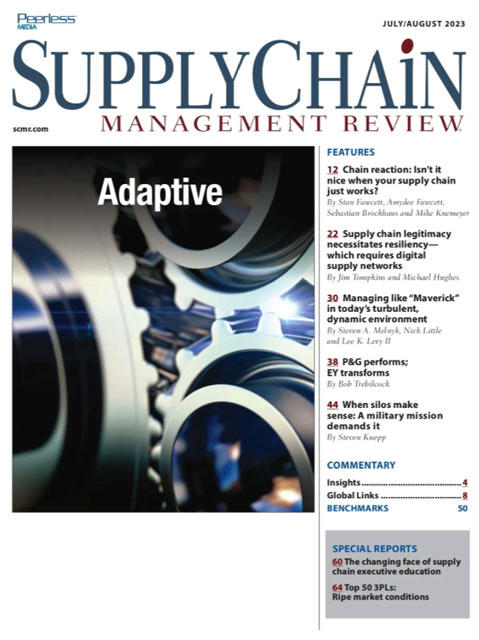Sorry, but your login has failed. Please recheck your login information and resubmit. If your subscription has expired, renew here.
July-August 2023
Most business people have heard the phrase “move fast and break things.” But how do you move fast, break things, and remain profitable? Inside this issue of Supply Chain Management Review are the answers—we hope. We have two articles this month that address decision-making. The articles (“Chain reaction: Isn’t it nice when your supply chain just works?” and “Managing like ‘Maverick’ in today’s turbulent, dynamic environment”) approach the topic of decision-making from decidedly different perspectives, but I believe they are more similar than they appear. Browse this issue archive.Need Help? Contact customer service 847-559-7581 More options
In March 2020, as COVID-19 and lockdowns ravaged the globe, I, James A. Tompkins, Ph.D., founder of 15 companies, writer and contributor to more than 30 books, recipient of 50-plus awards for service to his profession (including the prestigious Frank and Lillian Gilbreth Industrial Engineering Award from the Institute of Industrial and Systems Engineers), was deemed legitimate—by my wife, of all people.
I told Shari that I had never questioned my parents.
However, as Shari explained, for our decades of marriage, she had described my profession to her friends, my friends, our children and our grandchildren. And still, no one had a clue what I did for a living.
“But for the last four nights on the evening news, they’re talking supply chain, supply chain, supply chain,” Shari said. “So now all my friends go, ‘Oh, that’s what Jim does.’”
Because in 2020, supply chain was the tidal wave devouring the surfboards of enterprises and entrepreneurs worldwide, ripping old paradigms out with the tide right and left. COVID-19 moved from country to country, with industries and transport alternately locking down and opening back up. Leaders and managers struggled to fill demand that skyrocketed in some sectors and plunged in others.
All of a sudden, business leaders realized they needed supply chain insight at the C-level. Supply chain professionals estimate that their representation on boards of directors and elevation to chief supply chain officers have increased tenfold, and “supply chain” is mentioned more than ever on quarterly earnings calls.
Supply chain leaders must take advantage of this newfound respect to push for Digital Supply Networks, which bring end-to-end visibility to problems way upstream and downstream, along with the actionability necessary to solve such problems.
Such networks would have helped immensely, as COVID-19 surfaced troubling issues with our current non-resilient supply chains, issues that made it beyond the boardroom and impacted consumers, ranging from material and product shortages to supply chain disruptions to the rising cost of goods sold.

This complete article is available to subscribers only.
Log in now for full access or start your PLUS+ subscription for instant access.
SC
MR
Sorry, but your login has failed. Please recheck your login information and resubmit. If your subscription has expired, renew here.
July-August 2023
Most business people have heard the phrase “move fast and break things.” But how do you move fast, break things, and remain profitable? Inside this issue of Supply Chain Management Review are the answers—we… Browse this issue archive. Access your online digital edition. Download a PDF file of the July-August 2023 issue.In March 2020, as COVID-19 and lockdowns ravaged the globe, I, James A. Tompkins, Ph.D., founder of 15 companies, writer and contributor to more than 30 books, recipient of 50-plus awards for service to his profession (including the prestigious Frank and Lillian Gilbreth Industrial Engineering Award from the Institute of Industrial and Systems Engineers), was deemed legitimate—by my wife, of all people.
I told Shari that I had never questioned my parents.
However, as Shari explained, for our decades of marriage, she had described my profession to her friends, my friends, our children and our grandchildren. And still, no one had a clue what I did for a living.
“But for the last four nights on the evening news, they’re talking supply chain, supply chain, supply chain,” Shari said. “So now all my friends go, ‘Oh, that’s what Jim does.’”
Because in 2020, supply chain was the tidal wave devouring the surfboards of enterprises and entrepreneurs worldwide, ripping old paradigms out with the tide right and left. COVID-19 moved from country to country, with industries and transport alternately locking down and opening back up. Leaders and managers struggled to fill demand that skyrocketed in some sectors and plunged in others.
All of a sudden, business leaders realized they needed supply chain insight at the C-level. Supply chain professionals estimate that their representation on boards of directors and elevation to chief supply chain officers have increased tenfold, and “supply chain” is mentioned more than ever on quarterly earnings calls.
Supply chain leaders must take advantage of this newfound respect to push for Digital Supply Networks, which bring end-to-end visibility to problems way upstream and downstream, along with the actionability necessary to solve such problems.
Such networks would have helped immensely, as COVID-19 surfaced troubling issues with our current non-resilient supply chains, issues that made it beyond the boardroom and impacted consumers, ranging from material and product shortages to supply chain disruptions to the rising cost of goods sold.
SC
MR


Latest Supply Chain News
- April manufacturing output slides after growing in March
- Q1 sees a solid finish with positive U.S.-bound import growth, notes S&P Global Market Intelligence
- World Trade Centers offers a helping hand to create resilient, interconnected supply chains
- 6 Questions With … Sandeep Bhide
- MIT CTL offering humanitarian logistics course
- More News
Latest Podcast

 Explore
Explore
Procurement & Sourcing News
- April manufacturing output slides after growing in March
- World Trade Centers offers a helping hand to create resilient, interconnected supply chains
- Bridging the ESG gap in supply chain management: From ambition to action
- Israel, Ukraine aid package to increase pressure on aerospace and defense supply chains
- How CPG brands can deliver on supplier diversity promises
- How S&OP provides the answer to in-demand products
- More Procurement & Sourcing
Latest Procurement & Sourcing Resources

Subscribe

Supply Chain Management Review delivers the best industry content.

Editors’ Picks






